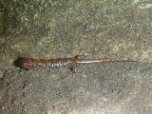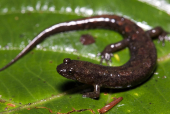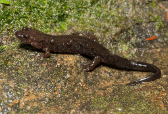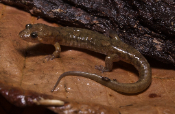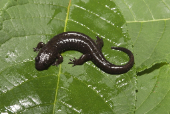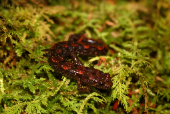Cumberland Dusky Salamander (Desmognathus abditus)
Description: Coloration in this species (2.5 to 4.5 inches in length) is highly variable. They have a round tail and a light line from the eye to the angle of the jaw. Some individuals may have a stripe down the back that can vary in color from yellow to orange, red, or brown. This stripe can be irregular or straight.
Other individuals may have spotting or flecking on the back instead of a dorsal stripe and others, especially males, may be dark with little or no patterning. Some individuals may exhibit red legs or cheek patches.
Habitat: All known specimens have been found under rocks in streams or within a metre (yard) of flowing water and a favoured location is moss-covered rocks behind cascades.
Range: Prior to 2003 the Allegheny Mountain dusky salamander (Desmognathus ochrophaeus) had been thought to be a single species but studies using nucleic acid sequencing and agar gel electrophoresis have since shown it to be a species complex. The Cumberland dusky salamander is one of five members of this complex and has been found at several sites in Tennessee on the Cumberland Plateau. The most northerly of these is near Wartburg in Morgan County and the most southerly is on the southern side of the Cumberland Plateau near Tracy City in Grundy County.
Found in these States:
TN
Diet: It is likely that the Cumberland dusky salamander feeds on small invertebrates found in leaf litter.
Reproduction: Females deposit their eggs under moss, rocks, or logs or under logs in or near flowing water. The female remains with her eggs until they hatch. Hatchling salamanders emerge from their eggs with external gills and spend up to 10 months as fully aquatic larvae before transforming into adults.
Status: Listed a Vulnerable because of its limited extent of occurrence (EOO) of 6,280 km2 (but which is unlikely to exceed 13,528 km2), its population is thought to be severely fragmented, and there is ongoing decline in the quality and extent of its habitat.
»» Kingdom: Animalia - Animals
»» Phylum: Chordata - Chordates
»» Subphylum: Vertebrata - Vertebrates
»» Class: Amphibia - (Amphibians)
»» Order: Caudata - Salamanders
»» Family: Plethodontidae - Lungless Salamanders
»» Genus: Desmognathus
»» Species: Desmognathus abditus - Cumberland Dusky Salamander
This article uses material from the Wikipedia article "Cumberland Dusky Salamander", which is released under the Creative Commons Attribution-Share-Alike License 3.0. Content may have been omitted from the original, but no content has been changed or extended.
|


